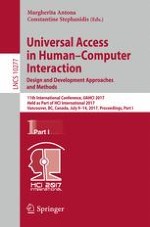The three-volume set LNCS 10277-10279 constitutes the refereed proceedings of the11th International Conference on Universal Access in Human-Computer Interaction, UAHCI 2017, held as part of the 19th International Conference on Human-Computer Interaction, HCII 2017, in Vancouver, BC, Canada in July 2017, jointly with 14 other thematically similar conferences. The total of 1228 papers presented at the HCII 2017 conferences were carefully reviewed and selected from 4340 submissions. The papers included in the three UAHCI 2017 volumes address the following major topics: Design for All Methods and Practice; Accessibility and Usability Guidelines and Evaluation; User and Context Modelling and Monitoring and Interaction Adaptation; Design for Children; Sign Language Processing; Universal Access to Virtual and Augmented Reality; Non Visual and Tactile Interaction; Gesture and Gaze-Based Interaction; Universal Access to Health and Rehabilitation; Universal Access to Education and Learning; Universal Access to Mobility; Universal Access to Information and Media; and Design for Quality of Life Technologies.
